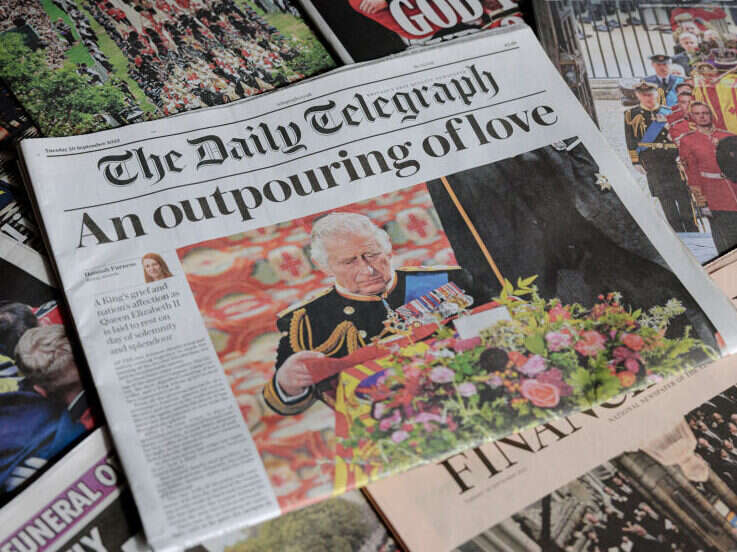
New data shows half of The Telegraph readers in print and online identify as Conservative supporters, with the audience skewing older and male.
The politically influential The Telegraph is one of the UK’s best-known broadsheet dailies and has long been a bastion of the UK’s political right.
The Telegraph titles are soon to be put up for sale after Lloyds Banking Group has effectively repossessed the business over debts thought to be around £1bn owed by owners the Barclay family. Members of the Barclay family have recently been ousted as directors of the Telegraph Media Group.
A number of names have been touted as buyers of the more than 150-year-old title including the Daily Mail owner, DMGT, Mediahuis, Axel Springer and the states of Saudi Arabia or Qatar.
The Telegraph reader data from Yougov Profiles
New data from Yougov Profiles, which was based on continuously collected information and rolling surveys, show that nearly half (49%) of The Telegraph’s print and online readership identify as supporters of the Conservative party.
That compares to the average of 28% for readers of other newspaper brands. The question asked was: “Generally speaking, do you think of yourself as Labour, Conservative, Liberal Democrat or what?” with a list of UK political parties to choose from.
Yougov defines a Telegraph reader as someone who says they read The Telegraph’s print edition, website or app at least once per month.
According to Yougov, more of The Telegraph’s readership is male (69%) compared with other newspapers (49% on average).
More than a fifth (22%) are affluent, with an income above twice the median (compared with 15% of readers of other newspapers).
The Telegraph readers also skew older with 38% of its readership aged 60 and above, compared with 30% for other titles.
The Telegraph has a higher proportion of young readers, with over four in ten (43%) aged between 18–39, compared with 37% on average elsewhere. Fewer readers of The Telegraph are, however, aged between 40–59 (19% versus 32% for other papers).
Readers of The Telegraph are also more likely to say that they use advertising to help them decide on purchases (50% compared to 33% for other newspaper readers). The same proportion said they often pay attention to newspaper adverts, compared to less than a third (32%) of readers of other news brands.
Yougov noted that The Telegraph readers are valuable to advertisers, particularly in industries including automobiles, consumer electronics, luxury goods and financial products.
The Telegraph circulation and subscriptions
The Telegraph, along with the Times, the Sun, the Guardian and the Observer has stopped publicly sharing its print circulation data through the Audit Bureau of Circulations (ABC).
In December 2019, the last month for which data is available, the circulation of The Telegraph was 317,817, while The Sunday Telegraph reached 248,288.
The Telegraph said it had made the decision because print circulation was no longer a "key metric" as it put increased focus on its subscriber strategy.
The Telegraph went behind a hard paywall in 2016. Since then, the brand has rapidly grown its number of paying subscribers, most recently reporting 586,867 digital subscriptions in December 2022 out of a total of 733,731 subscriptions across print and digital. Digital subscriptions were up 8% year-on-year and up 75% when compared with October 2020.
The Telegraph came in 14th position in the last update of Press Gazette's 100k Club, which ranks the English-language publishers with the most digital subscriptions worldwide.
Audiences neutral on trust in The Telegraph
A recent Yougov survey found that The Telegraph came mid-table (17) among the 32 UK news brands included in a survey on trust in news.
The Telegraph had a net trust score of 0, with 9% of people saying the outlet was "very untrustworthy", 15% saying it was "untrustworthy", 25% as "neither trustworthy nor untrustworthy", 22% as "trustworthy" and 2% reporting as "very trustworthy".
Who reads The Telegraph online?
Ipsos iris data from May shows The Telegraph reached 16.2 million people aged over 15 in the UK, and it regularly ranks among the top ten most popular news brands in the UK in Press Gazette's monthly top 50 rankings.
According to the Ipsos iris affinity index, 51% of The Telegraph's online readership in May was female and 49% was male. The difference with the Yougov Profiles data may be due to differences in the reporting period and/or the exclusion of The Telegraph print readers in Ipsos' data.
Men, however, spent more time with the brand with 342.6 million minutes compared with 276.7 million for women.
Over 55s made up the single largest group of online readers of The Telegraph (39%). The 45–54 age group made up 18%, the 35–44 group counted for 17%, while 25–34-year-olds made up 15% and 15–24-year-olds comprised 11%.
Some 86% of The Telegraph's digital audience in the UK was in England. By region, the largest proportion of online readers was in London (15%) followed by 14% in the South East and 10% each in the North West and East of England.
Email pged@pressgazette.co.uk to point out mistakes, provide story tips or send in a letter for publication on our "Letters Page" blog
